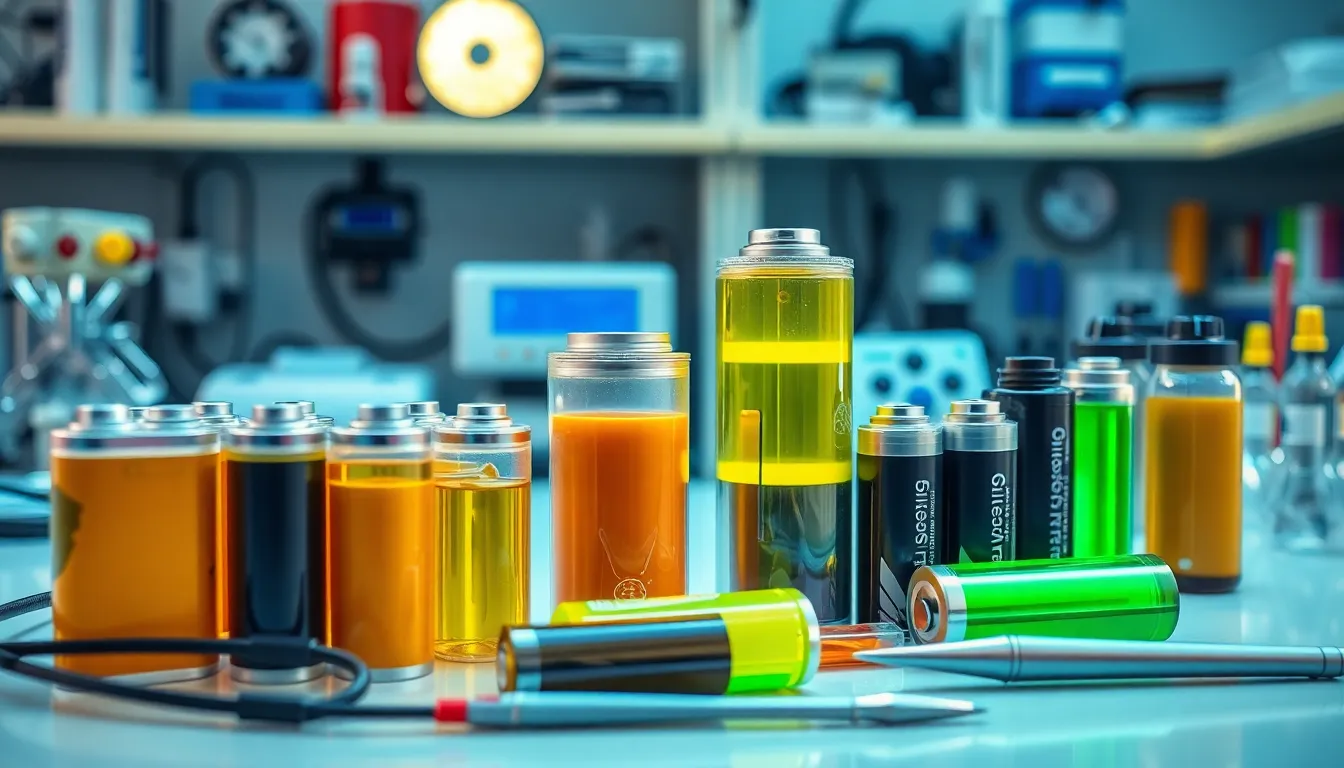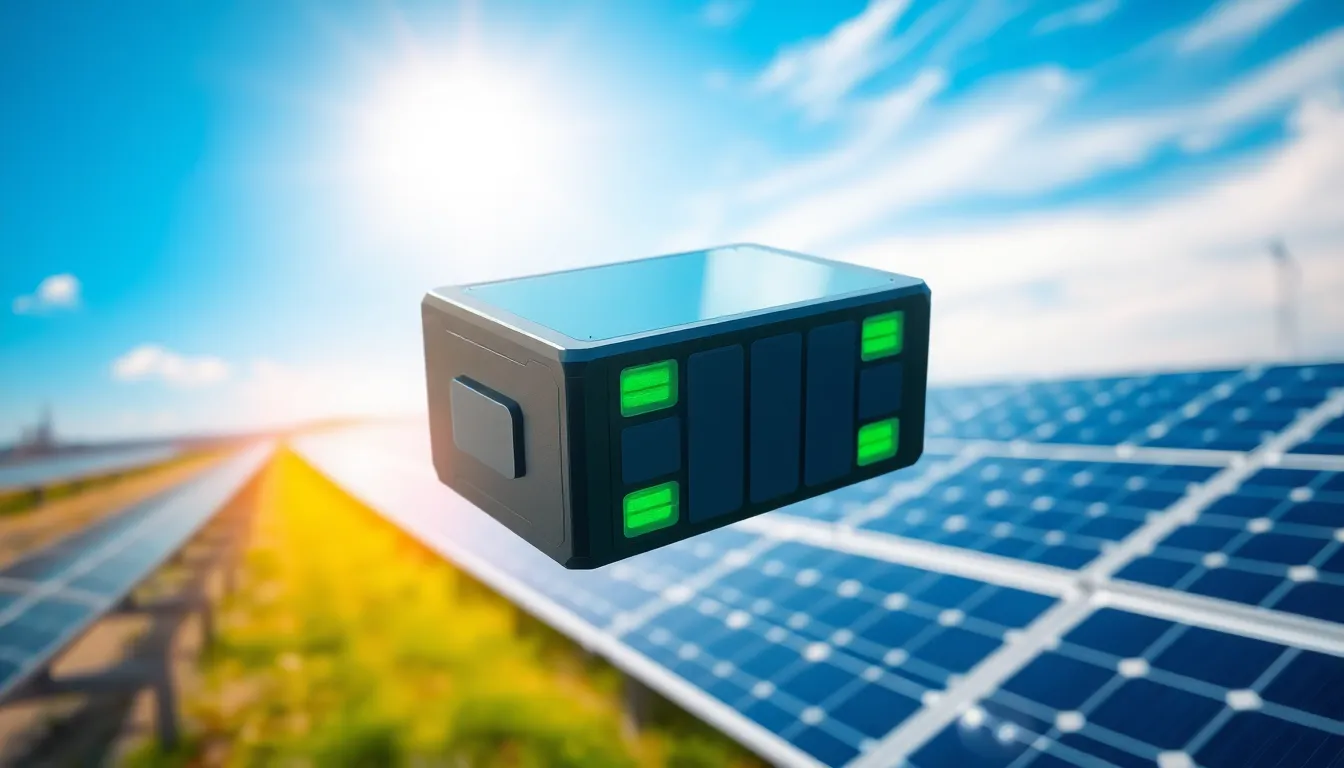In a world where every gadget seems to need a charge faster than you can say “low battery,” sustainable battery technology is stepping into the spotlight like a superhero in a power suit. Forget about the days of toxic waste and energy vampires draining our planet’s resources. The new wave of batteries is here to save the day, offering eco-friendly solutions that are as reliable as your morning coffee.
Table of Contents
ToggleOverview of Sustainable Battery Technology
Sustainable battery technology addresses the environmental challenges posed by traditional battery systems. Innovations focus on using eco-friendly materials, such as sodium and organic compounds, instead of harmful heavy metals. These advancements reduce toxic waste, enhancing recycling capabilities and resource sustainability.
Lithium-ion batteries dominate the market, but their production impacts the environment. Researchers are exploring alternatives like solid-state batteries, which offer enhanced safety and efficiency. These batteries utilize solid electrolytes, minimizing flammability risks found in conventional designs.
Cost-effectiveness becomes a critical factor as businesses seek affordability alongside sustainability. Developers aim to lower production costs with increased efficiency in manufacturing processes. Improved energy densities allow batteries to store more energy in a compact form, making them more practical for high-demand applications.
Integration of renewable energy sources plays a significant role in the growth of sustainable battery technology. Solar and wind energy can pair with energy storage solutions for effective grid stabilization. Policies promoting clean energy initiatives encourage innovation, leading to government-backed funding for research and development.
Consumer awareness also drives the demand for sustainable options. As individuals become more environmentally conscious, they seek products aligned with their values. Brands that adopt sustainable practices gain a competitive edge through enhanced customer loyalty.
Continued research will refine sustainable battery technology for lighter, safer, and more efficient solutions. An emphasis on lifecycle management ensures these batteries will perform well from production through end-of-life disposal. Sustainable battery technology embodies a critical step toward achieving environmental goals in a gadget-driven world.
Types of Sustainable Battery Technologies


Sustainable battery technologies are evolving, driven by the need for cleaner, more efficient energy solutions. Innovations now focus on improving existing models and developing new alternatives.
Lithium-Ion Innovations
Lithium-ion technology is adapting to meet sustainable goals. Researchers aim to enhance the efficiency of lithium-ion batteries, minimizing resource depletion and toxic waste generation. New methods focus on recycling lithium from old batteries, which reduces the environmental impact. Other innovations include the use of silicon in anodes, which increases energy density. Improved charging cycles also lead to longer battery life, aligning performance with sustainability. These advancements enhance the overall reliability of lithium-ion batteries while decreasing their carbon footprint.
Solid-State Batteries
Solid-state batteries present a transformative option in sustainable battery technology. Characterized by the use of solid electrolytes, these batteries offer greater safety and energy density compared to traditional options. Reduced flammability addresses many safety concerns linked to liquid electrolyte batteries. Additionally, solid-state batteries feature a longer lifespan, minimizing electronic waste. Their compatibility with renewable energy sources fosters a seamless integration into sustainable energy systems. As development continues, these batteries could play a crucial role in the transition toward a more sustainable energy future.
Benefits of Sustainable Battery Technology
Sustainable battery technology offers numerous advantages, particularly in terms of environmental and economic impacts.
Environmental Impact
Sustainable battery technology significantly reduces waste generated by traditional batteries. Using eco-friendly materials, such as sodium and organic compounds, decreases toxicity levels in landfills. Enhanced recycling capabilities further minimize material wastage and encourage efficient resource use. Innovations like solid-state batteries improve safety and lifespan, leading to fewer replacements over time. These improvements contribute to lower greenhouse gas emissions. Companies adopting these technologies benefit from a positive public image, as consumers increasingly favor environmentally responsible products.
Economic Advantages
Cost-effectiveness plays a crucial role in the adoption of sustainable battery technology. Lower production costs make these batteries accessible for various applications. Improved energy densities result in longer-lasting power, reducing the frequency of replacements and maintenance costs for consumers and businesses. Investing in sustainable options drives technological advancements and can lead to job creation in green industries. Governments often support this transition through incentives and funding, making sustainable solutions economically viable. Enhanced customer loyalty among environmentally conscious consumers further strengthens brands that prioritize sustainability.
Challenges Facing Sustainable Battery Technology
Sustainable battery technology faces significant challenges that impact its broader adoption and effectiveness.
Material Sourcing
Material sourcing presents obstacles in sustainable battery development. Extracting eco-friendly materials like sodium and organic compounds occurs less widely than lithium. Sourcing conflicts arise from competition for resources, complicating the transition away from lithium-ion batteries. Moreover, the extraction processes for some materials carry environmental risks, including habitat destruction and water pollution. Innovations must focus on developing sustainable mining practices to minimize these impacts. Sustainable sourcing initiatives can enhance transparency and traceability, assuring consumers about the environmental footprint. Collaborative efforts between companies and governments also play a key role in establishing responsible sourcing guidelines.
Recycling and Disposal
Recycling and disposal signify critical challenges for sustainable batteries. Current recycling systems often inadequately process lithium-ion batteries, leading to waste and lost resources. In contrast, sustainable battery technologies need efficient recycling methods to recover materials effectively. Implementing advanced recycling techniques can significantly reduce overall environmental impact. Public awareness about proper disposal methods also requires improvement, as many consumers remain unaware of safe practices. Developing standardized disposal systems can streamline recycling processes and encourage participation. As research advances, creating batteries with design for recycling in mind may further increase efficiency and reduce waste.
Future Trends in Sustainable Battery Technology
Emerging trends are reshaping sustainable battery technology. Researchers focus on battery chemistries that leverage abundant materials, like sodium and organic compounds, making them more environmentally friendly. Solid-state batteries gain attention due to their higher safety and energy density, signaling a potential shift away from traditional lithium-ion batteries.
Integration of artificial intelligence is another development streamlining battery management systems. Smart technologies optimize energy use and enhance performance, aligning with sustainability goals. A growing number of companies are investing in automated recycling processes to reclaim valuable materials efficiently.
Government policies are also fostering innovation within the sustainable battery landscape. Regulations promoting circular economies emphasize recycling and waste reduction. Furthermore, private sector investments target cost reductions in production, while retaining high energy densities, ensuring that sustainable options remain competitive in the market.
Consumer demand for transparency drives brands to prioritize environmentally responsible practices. Companies that embrace sustainability often strengthen customer relationships by building trust and enhancing brand loyalty. Enhanced marketing around eco-friendly products boosts awareness, influencing purchasing decisions.
Innovative partnerships are emerging between academia and industry, focusing on collaboration for research and development. These alliances accelerate breakthroughs in battery technology, with shared resources leading to faster implementation of sustainable practices. Education around sustainable technologies remains crucial. Awareness campaigns inform consumers about the benefits of sustainable batteries, driving acceptance and encouraging adoption.
Lastly, future advancements aim to enhance lifecycle management. Engineers are working on designs that facilitate recycling and reusability, ensuring that batteries maintain value throughout their lifespan. As these trends evolve, the trajectory of sustainable battery technology becomes clearer, indicating a promising future for the industry.
Sustainable battery technology is paving the way for a greener future. By focusing on eco-friendly materials and innovative recycling methods, it addresses the pressing environmental challenges posed by traditional batteries. The shift toward alternatives like solid-state batteries highlights the industry’s commitment to safety and efficiency.
As consumer awareness grows, demand for sustainable options will likely continue to rise. Companies that prioritize these practices not only enhance their public image but also tap into a market that values environmental responsibility.
With ongoing research and development, the future of sustainable battery technology looks bright. It promises to deliver solutions that align with both economic viability and environmental sustainability, making it an essential component of the transition to a cleaner, more sustainable world.

